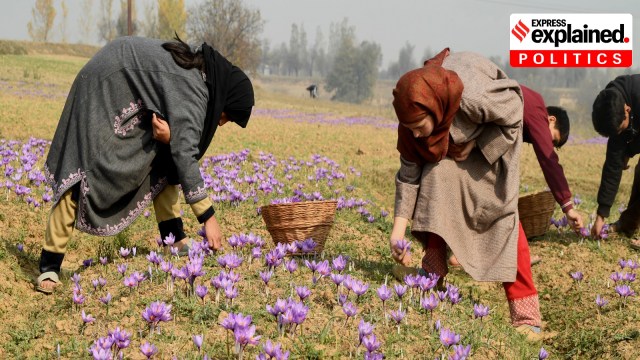Who is a J&K resident? This is how successive govts defined inhabitants of erstwhile state
The central government changed the provisions defining permanent residents of Jammu and Kashmir after the constitutional changes of August 5, 2019. Who were the ‘permanent residents’ of the state before that?
 Speaking in Lok Sabha on December 6, Home Minister Amit Shah said the proposed laws would benefit migrant Kashmiris, women, and “those deprived of their rights for the last 70 years”.(Express Photo: Shuaib Masoodi)
Speaking in Lok Sabha on December 6, Home Minister Amit Shah said the proposed laws would benefit migrant Kashmiris, women, and “those deprived of their rights for the last 70 years”.(Express Photo: Shuaib Masoodi) In the national debate over Jammu and Kashmir in Parliament, the Supreme Court, and among ordinary citizens, the “people” have been repeatedly invoked — in the context of securing or denying them their rights, and of taking decisions in or against their interest. Speaking in Lok Sabha on December 6 ahead of the passage of The Jammu and Kashmir Reservation (Amendment) Bill, 2023, and The Jammu and Kashmir Reorganisation (Amendment) Bill, 2023, Home Minister Amit Shah said the proposed laws would benefit migrant Kashmiris, women, and “those deprived of their rights for the last 70 years”.
Who are the “state subjects”, “permanent residents”, and “domiciles” of J&K? Since the time of the Dogra rulers of the erstwhile princely state, successive governments have sought to define the real inhabitants of Jammu and Kashmir.
1927: Four classes of state subjects of Maharaja Hari Singh
On April 20, 1927, the Dogra ruler of J&K, Maharaja Hari Singh, issued Government Order No. I-L/84, designating the inhabitants of his princely state as “state subjects”, and dividing them into four categories.
Class I state subjects were those who were born and were resident in the state before the commencement of the reign of Maharaja Gulab Singh, the first Dogra king, in 1846; as well as those who had settled in J&K and had been permanently residing in the state before the commencement of Samvat year 1942, corresponding to 1885.
Class II included people who had come from other places and permanently settled in J&K, and had acquired immoveable property there before the close of Samvat year 1968 (1911), when Maharaja Pratap Singh was on the throne.
Class III subjects included permanent residents who had acquired under a “rayatnama” (concession) any immovable property in J&K, and those who might have subsequently acquired any such property under an “ijazatnama” (permission).
Class IV included companies of public nature registered within the then state, and in which the government was financially interested, or satisfied about their financial stability, or which were of economic benefit to the state. These entities were declared state subjects by a special order of the Maharaja.
Under the 1927 order, the state subjects of Class I were to receive preference over other classes of subjects, and state subjects of Class II were to be privileged over Class III, in matters of grant of state scholarships, state lands for purposes of agriculture and building a house, and for recruitment to state service.
The order also said that the descendants of persons who were state subjects of any class would be entitled to become state subjects of the same class; and the wife or widow of a state subject of any class shall acquire the status of her husband as state subject of the same class as her husband, so long as she resides in the state and does not take up permanent residence elsewhere.
1932: State subjects living abroad, and foreign nationals in J&K
On June 27, 1932, Hari Singh issued another order (No. 13L/1989) determining the status of state subjects of J&K living in foreign countries, and to inform the governments of foreign states as to the position of their nationals staying in his state.
Thus, all emigrants from J&K to foreign territories, and their descendants born abroad for two generations, were to be considered state subjects. However, these nationals of J&K shall not be entitled to claim the internal rights granted to the subjects of the state by law, unless they fulfilled the conditions laid down by those laws and the rules for the specific purposes mentioned therein.
On foreign nationals residing in J&K, the order said they shall not acquire the nationality of the state until after the age of 18, and on purchasing immovable property under an ijazatnama, and on obtaining a rayatnama after 10 years of continuous residence as laid down in the 1927 order.
1956: Under the constitution of the erstwhile state of J&K
On November 17, 1956, the Constituent Assembly of Jammu and Kashmir adopted a separate constitution for the then state, which redefined state subjects as “permanent residents”. It said that every person who is, or is deemed to be a citizen of India under the provisions of the Constitution of India shall be a permanent resident of the state, if on May 14, 1954, he was a state subject of Class I or of Class II or, after having lawfully acquired immoveable property had been ordinarily resident in the state for not less than 10 years prior to that date.
About people who were Class I/ II state subjects, and who had migrated to areas which later became part of Pakistan, the J&K constitution said that if such a person returns to the state under a permit for resettlement or for permanent return issued by or under the authority of any law made by the state legislature, he shall on such return be a permanent resident of the state.
In 1980, the government of Chief Minister Sheikh Abdullah brought the J&K Resettlement Bill, which was passed by both Houses of the state legislature in 1982. However, it could not be implemented as the late Prof Bhim Singh, who was then president of the Panthers Party, obtained a stay from the Supreme Court.
2003-04: HC order and Mufti govt Bill on status of women residents
After the adoption of the J&K constitution, women were made to lose their status of permanent resident if they married a person from outside the state. This changed after a full bench of the state High Court ruled in a majority verdict in 2003 that there was no provision in the 1927 notification or in the Jammu and Kashmir constitution that on marrying a non-permanent resident, the daughter of a permanent resident shall lose her status as a permanent resident of the state.
To get around the court’s judgment, the then PDP-Congress coalition government of Mufti Muhammad Sayeed passed the Permanent Residents (Disqualification) Bill in the Assembly in 2004. It provided that a woman, if married to a non-permanent resident, would lose her own permanent resident status. The opposition National Conference (NC) supported the Bill. However, despite the NC’s support, the Bill did not pass in the Legislative Council after the Congress changed its mind and opposed it.
After 2019: Relaxing the definition, identifying ‘domiciles’ of the UT
After the August 5-6, 2019 amendment of Article 370 and bifurcation of J&K into two Union Territories, the central government redefined “permanent residents” of J&K as “domiciles”. The new definition said that anyone could be a domicile of the UT of J&K if they had resided therein for 15 years; or studied there for seven years and appeared for their Class 10/12 examination in an educational institution in J&K; or those who had registered as migrants, and their children. It included the children of officials of the central government, including All India Service officers, Public Sector Undertakings, autonomous bodies, recognised research institutes, and central universities who had served in J&K for a total of 10 years.
- 01
- 02
- 03
- 04
- 05






































